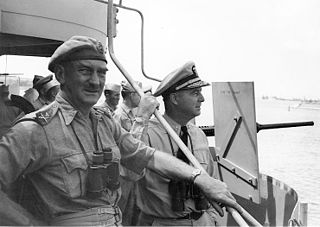Related Research Articles

The Battle of Monte Cassino, also known as the Battle for Rome, was a series of four military assaults by the Allies against German forces in Italy during the Italian Campaign of World War II. The objective was to break through the Winter Line and facilitate an advance towards Rome.

The Battle of Anzio was a battle of the Italian Campaign of World War II that commenced January 22, 1944. The battle began with the Allied amphibious landing known as Operation Shingle, and ended on June 4, 1944, with the liberation of Rome. The operation was opposed by German and by Italian Repubblica Sociale Italiana (RSI) forces in the area of Anzio and Nettuno.

General Lucian King Truscott Jr. was a highly decorated senior United States Army officer, who saw distinguished active service during World War II. Between 1943–1945, he successively commanded the 3rd Infantry Division, VI Corps, Fifteenth Army and Fifth Army, serving mainly in the Mediterranean Theater of Operations (MTO) during his wartime service. He and Alexander Patch were the only U.S. Army officers to command a division, a corps, and a field army in combat during the war.

The 15th Army Group was an army group in World War II, composed of the British Eighth Army and initially the Seventh United States Army (1943), replaced by the Fifth United States Army, which apart from units from across the British Empire and United States, also had entire units from other allied countries/regions, including: one corps from Free France and one from Poland; one division from Brazil; multiple separate brigades of Italians and Greeks; plus support to, and from, local Italian partisans. It operated in the Italian Campaign from 1943 to 1945.

Operation Avalanche was the codename for the Allied landings near the port of Salerno, executed on 9 September 1943, part of the Allied invasion of Italy during World War II. The Italians withdrew from the war the day before the invasion, but the Allies landed in an area defended by German troops. Planned under the name Top Hat, it was supported by the deception plan Operation Boardman.

The 51st (Highland) Division was an infantry division of the British Army that fought on the Western Front in France during the First World War from 1915 to 1918. The division was raised in 1908, upon the creation of the Territorial Force, as the Highland Division and later 51st (Highland) Division from 1915. The division's insignia was a stylised 'HD' inside a red circle. Early doubts about the division's performance earned it the nickname of "Harper's Duds" after the name of its commander, Major-General George Harper although they would go on to gain a fearsome reputation with the Allies and Germans.

The Allied invasion of Italy was the Allied amphibious landing on mainland Italy that took place from 3 September 1943, during the Italian campaign of World War II. The operation was undertaken by General Sir Harold Alexander's 15th Army Group and followed the successful Allied invasion of Sicily. The main invasion force landed on the west coast of Italy at Salerno on 9 September as part of Operation Avalanche, while two supporting operations took place in Calabria and Taranto.

The 2nd New Zealand Division, initially the New Zealand Division, was an infantry division of the New Zealand Military Forces during the Second World War. The division was commanded for most of its existence by Lieutenant-General Bernard C. Freyberg. It fought in Greece, Crete, the Western Desert and Italy. In the Western Desert Campaign, the division played a prominent role in the defeat of German and Italian forces in the Second Battle of El Alamein and the British Eighth Army's advance to Tunisia.

XXX Corps was a corps of the British Army during the Second World War. The corps was formed in the Western Desert in September 1941. It provided extensive service in the North African Campaign and many of its units were in action at the Second Battle of El Alamein in late 1942. It then took part in the Tunisia Campaign and formed the left flank during the Allied invasion of Sicily in 1943.

General Sir Richard Loudon McCreery, was a career soldier of the British Army, who was decorated for leading one of the last cavalry actions in the First World War. During the Second World War, he was chief of staff to General Sir Harold Alexander at the time of the Second Battle of El Alamein, and later commanded the British Eighth Army, fighting in the Italian campaign from October 1944 until the end of the war, leading it to victory in the final offensive in Italy.

X Corps was a corps of the British Army that served in the First World War on the Western Front before being disbanded in 1919. The corps was re-formed in 1942 during the Second World War and saw service in the North African Campaign and the Italian Campaign where it came under command of the US Fifth Army and the British Eighth Army.

The Battle of San Pietro Infine was a major engagement from 8–17 December 1943, in the Italian Campaign of World War II involving Allied forces attacking from the south against heavily fortified positions of the German "Winter Line" in and around the town of San Pietro Infine, just south of Monte Cassino about halfway between Naples and Rome.
The 1917 French Army mutinies took place amongst French Army troops on the Western Front in northern France during World War I. They started just after the unsuccessful and costly Second Battle of the Aisne, the main action in the Nivelle Offensive in April 1917. The new French commander of the armies in France, General Robert Nivelle, had promised a decisive victory over the Germans in 48 hours; morale in French armies rose to a great height and the shock of failure soured their mood overnight.

The United States Army North (ARNORTH) is a formation of the United States Army. An Army Service Component Command (ASCC) subordinate to United States Northern Command (NORTHCOM), ARNORTH is the joint force land component of NORTHCOM. ARNORTH is responsible for homeland defense and defense support of civil authorities. ARNORTH is headquartered at Fort Sam Houston, Texas. Redesignated ARNORTH in 2004, it was first activated in early January 1943 as the United States Fifth Army, under the command of Lieutenant General Mark W. Clark.

Lieutenant-General Sir John Ledlie Inglis Hawkesworth, was a senior British Army officer who served during both World Wars. During the Second World War he commanded the 4th Division during the Tunisian Campaign in early 1943, later commanding the 46th Division throughout most of the Italian Campaign and, finally, X Corps in Greece, before suffering from a fatal heart attack in June 1945.

Major General Douglas Alexander Henry Graham, was a senior British Army officer who fought with distinction in both world wars. He is most notable during the Second World War for commanding the 153rd Brigade of the 51st (Highland) Division in North Africa from 1942 to 1943, later being the General Officer Commanding (GOC) of the 56th (London) Infantry Division during the Salerno landings in Italy in September 1943 and the 50th (Northumbrian) Infantry Division during the Normandy landings in France in June 1944.

Operation Achse, originally called Operation Alaric, was the codename for the German operation to forcibly disarm the Italian armed forces after Italy's armistice with the Allies on 3 September 1943.

At the start of 1939, the British Army was, as it traditionally always had been, a small volunteer professional army. At the beginning of the Second World War on 1 September 1939, the British Army was small in comparison with those of its enemies, as it had been at the beginning of the First World War in 1914. It also quickly became evident that the initial structure and manpower of the British Army was woefully unprepared and ill-equipped for a war with multiple enemies on multiple fronts. During the early war years, mainly from 1940 to 1942, the British Army suffered defeat in almost every theatre of war in which it was deployed. But, from late 1942 onwards, starting with the Second Battle of El Alamein, the British Army's fortunes changed and it rarely suffered another defeat. While there are a number of reasons for this shift, not least the entrance of both the Soviet Union and the United States in 1941, as well as the cracking of the Enigma code that same year, an important factor was the stronger British Army. This included better equipment, leadership, training, better military intelligence and mass conscription that allowed the army to expand. During the course of the war, eight men would be promoted to the rank of Field Marshal, the army's highest rank. By the end of the Second World War in September 1945, over 3.5 million men and women had served in the British Army, which had suffered around 720,000 casualties throughout the conflict.

Major General Lewis Owen Lyne, was a British Army officer who served before and during the Second World War, rising from the rank of lieutenant colonel in 1939 to major general in early 1944. His active service began in mid-1943 when in command of the 169th Brigade in action in North Africa and Italy from 1943 to 1944, followed by the 59th Division during the Battle of Normandy in mid-1944, finally commanding the 7th Armoured Division during the final stages of the Northwestern Europe Campaign until Victory in Europe Day in May 1945. He retired from the army in 1949.
The Allied invasion of Italy, a phase of the Mediterranean Theater of World War II, took place on 3 September at Reggio di Calabria, and on 9 September 1943 at Taranto and Salerno. Allied naval forces landed American and Commonwealth troops on the beaches of southern Italy where they faced resistance from Axis forces.
References
- ↑ Whicker, Alan. Whicker's War HarperCollins 2005 pp87-8 ISBN 0007205074
- ↑ Saul, p. 88
- 1 2 3 "Salerno Mutineers". Hansard. 22 March 2000. Retrieved 25 May 2020.
- ↑ Bainton, Roy (August 2003). "The Salerno Mutiny of 1943". History Magazine. BBC. Archived from the original on September 4, 2006. Retrieved 2007-06-28.